Guide By – Los Angeles Truck Accident Lawyer
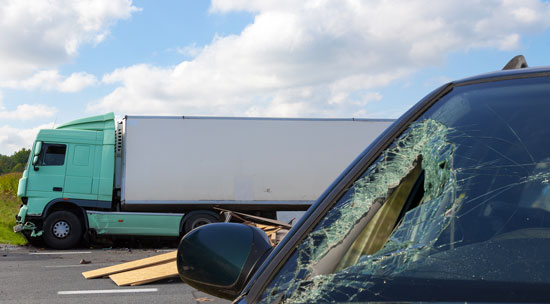 This firm pursues justice on behalf of truck accident victims with passionate dedication. Cherepinskiy Law Firm, the Los Angeles truck accident lawyer, provides legal services throughout Southern California and will work tirelessly from the start of the case through a trial, if necessary, in order to obtain the maximum compensation.
This firm pursues justice on behalf of truck accident victims with passionate dedication. Cherepinskiy Law Firm, the Los Angeles truck accident lawyer, provides legal services throughout Southern California and will work tirelessly from the start of the case through a trial, if necessary, in order to obtain the maximum compensation.
We see trucks everywhere. Trucks are an extremely useful and convenient method of transporting freight. Over the last hundred plus years, trucks have dramatically evolved. Until the late 19th century, the majority of freight was carried by train or in horse-drawn trailers. Then, steam-powered trucks started transporting goods, but their career was very short-lived.
The early 20th century brought rapid changes and improvements in the design, power, and reliability of internal combustion engines. Since gasoline and diesel-powered trucks were considerably more powerful than steam-powered trucks, and capable of carrying more weight for longer distances, they quickly pushed steam engines out and became the undisputed leader in the freight transportation industry.
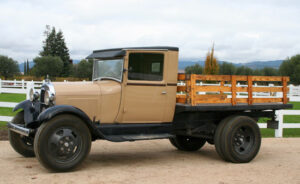
Unfortunately, the ubiquity of trucks on modern roads and highways has a negative aspect as well. Each year, there are thousands of truck accidents everywhere in the United States, including Los Angeles. The mere weight and size of a moving commercial truck turn it into a mighty force capable of crushing anything in its way, especially when moving at high speeds. Truck crashes that involve large commercial trucks – e.g. 18-wheelers, semi-trucks, and other heavy trucks – have the potential to be highly destructive and cause fatalities and serious long-lasting or permanent injuries. Statistically, the majority of truck accident victims are occupants of small passenger vehicles.
Accidents involving commercial trucks or tractor trailers tend to be extremely complex and zealously defended. Trucking companies spend considerable time and effort defending these cases, and they spare no expense in trying to make such cases as difficult as possible. In addition, the trucking industry is subject to various safety regulations. For instance, the Federal Motor Carrier Safety Administration (“FMCSA”), an agency of the United States Department of Transportation, is responsible for regulating the U.S. trucking industry. Through multiple regulations, including drug tests, limits on shift hours, and medical examinations, FMCSA’s main goal is to reduce heavy truck and bus crashes, fatalities, and injuries.
Victims of truck accidents require unique qualifications, protection, and guidance of an expert truck accident litigator. Cherepinskiy Law Firm, the Los Angeles truck accident attorney, has the expertise, thorough understanding of the Federal safety regulations, resources, and best-qualified experts to handle the most complex cases. If you make a decision to proceed with a legal action, this firm will provide capable, aggressive, as well as caring and compassionate representation.
Trucks are Very Dangerous
Weight
- The weight of a large truck can range from 10,000 to 80,000 pounds. By Federal law, the overall gross weight of loaded truck cannot exceed 80,000 pounds.
- Regular passenger vehicles weigh approximately 3,000 to 4,000 pounds.
- Trucks can be more than 25 times heavier than average passenger vehicles.
Braking Distance
- Trucks require more time and distance to stop than passenger vehicles.
- The brakes of large 18-wheelers are designed differently than passenger car brakes.
-
- Typical car brakes are hydraulic (liquid-based), which enables them to work virtually instantly – i.e. brake pads / shoes “grab” brake rotors / drums as soon as the driver hits the brake pedal.
-
- By comparison, large trucks have pneumatic (air-based) brakes. An engine-powered compressor fills special air storage tanks with compressed air. When the truck driver pushes the brake pedal, the compressed air has to leave the tank and flow to all wheels equipped with brake cylinders. This results in a brake lag – the time delay from the moment the pedal is hit to the moment the brakes actually start slowing the truck down.
- A passenger car with the weight of approximately 4,000 pounds traveling at a speed of 65 miles per hour will require approximately 316 feet to come to a full stop (i.e. almost the length of one football field).
- A fully loaded big-rig with the weight of 80,000 pounds and traveling at a speed of 65 miles per hour will require the braking distance of 525 feet (i.e. it will need the length of nearly two football fields to come to a complete stop).
Truck Accident Statistics
 Los Angeles truck accident lawyer at Cherepinskiy Law Firm has reviewed statistical data with respect to truck crashes. Based on the statistical analysis, including the data from the Federal Motor Carrier Safety Administration (“FMCSA”), the National Highway Traffic Safety Administration (“NHTSA”), and the California Department of Transportation (“Caltrans”), the truck accident numbers in the United States are staggering:
Los Angeles truck accident lawyer at Cherepinskiy Law Firm has reviewed statistical data with respect to truck crashes. Based on the statistical analysis, including the data from the Federal Motor Carrier Safety Administration (“FMCSA”), the National Highway Traffic Safety Administration (“NHTSA”), and the California Department of Transportation (“Caltrans”), the truck accident numbers in the United States are staggering:
- In the United States, there are over 15 million trucks.
- Nearly 13% of all trucks operating on the U.S. roads are 18-wheelers (also called “big rigs”, “semi-trucks”, “semitrailers”, “trailer trucks”, “truck trailers”, etc.).
Fatalities and Injuries Caused by Large Trucks
- Every year, large truck accidents cause injuries to more than 140,000 people.
- Every 16 minutes, one person is either killed or injured in a crash involving a heavy truck.
- For every 100 million miles that are driven on American roads, large truck crashes lead to approximately 2 fatalities and cause injuries to over 60 people.
- Each year, fatalities involving truck accidents impose a tremendous cost on the U.S. economy – over $20 billion.
- Over 20% of all accidents involving trucks cause injuries.
- In 2008, approximately 11% of fatal crashes involved heavy trucks with the weight of 10,000 pounds and more. That year, truck accidents caused deaths of 677 truck occupants.
- In 2015, the 415,000 reported truck accidents caused:
-
- over 4,000 deaths (approximately 1%) and
- over 80,000 injuries to drivers and passengers (approximately 20%)
- The average fatality rate for accidents involving large trucks is approximately 1% or roughly 1 DEATH PER EVERY 100 CRASHES. This number is 3 times higher than the average fatality rate for all vehicles on the U.S. roadways.
- In California, although the total number of truck crashes decreased during the period from 2005 to 2009, most of these truck crashes occurred in Los Angeles County.
Statistics Regarding the Causes of Truck Accidents
- Most truck accident fatalities involve two vehicles.
- Close to 90% of truck crashes are caused or contributed to by human error (as opposed to equipment malfunctions, weather conditions, and other causes). This includes negligence on the part of truck drivers themselves, as well drivers of other vehicles, passengers, motorcycle and bicycle riders, and even pedestrians.
- Individuals other than truck drivers (usually, passenger car drivers) cause approximately 75% of all truck crashes.
- Driver fatigue leads to approximately 30% of all truck accidents.
- As of 2007, over 20% of commercial truck drivers who were involved in a fatal truck accident – had a minimum one previous conviction for speeding.
Types of Truck Accident Injuries
A truck accident may lead to serious and catastrophic injuries, as well as a fatality. The following is the listing of the most common injuries that can be caused by a truck crash:
- Amputation and loss of limbs
- Back and neck injuries
- Bruising
- Blindness and eye injuries
- Burns
- Concussions
- Crush Injuries
- Cuts and scrapes
- Disfigurement and permanent scarring
- Fractures and broken bones (non-displaced, displaced, and compound fractures)
- Hearing Loss
- Hematomas (Internal bleeding)
- Internal injuries
- Joint Damage
- Post-Traumatic Stress Disorder (PTSD)
- Skin Injuries
- Soft tissue injuries
- Spinal cord injury and paralysis
- Traumatic brain injury (“TBI”)
- Whiplash
- Wrongful death
If you or a loved one has suffered any of the above injuries, you need to request that your case be analyzed by a Los Angeles truck accident lawyer.
Common Types of Trucks
These are some of the typical types of trucks, which can get involved in a truck crash:
By Chassis
Semi-trailer truck is the combination of a tractor (a powered truck also called “tractor cab”) and a semi-trailer. This type of a vehicle is also commonly referred to as a “semitrailer truck“, “18-wheeler“, “eighteen-wheeler“, “big rig“, “rig“, “semi“, “semi-truck“, “trailer truck“, “truck trailer“, “tractor-trailer“, and “semi-tractor trailer“. A semi-trailer gets attached to the tractor through a special fifth-wheel coupling called “hitch”. The tractor bears most of the weight of the semitrailer. Without the semi-trailer, the tractor cab itself has no freight-carrying capabilities.
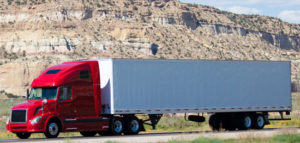
Doubles Truck (also known as “Twins” or “Twin Trailers”) is a combination of a tractor and two semitrailers connected in tandem with a converter dolly.
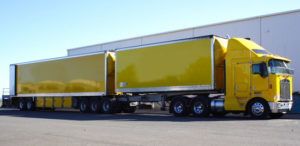
LCV (Long Combination Vehicle) is a trailer combination that is longer than a standard “doubles” combination (i.e. has more than two trailers). In some cases, LCVs can weigh more than 80,000 pounds. In the United States, LCVs are allowed in very rare circumstances: e.g. two 48-foot trailers or three 28-foot trailers.
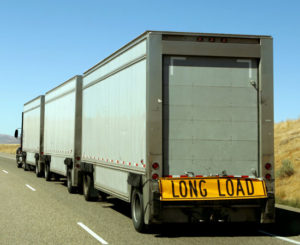
Rigid Truck (Straight Truck) is a truck, which carriers freight in a body mounted to its chassis. The tractor cab and the trailer are one unit without any articulation between them, as opposed to a semi truck (where a trailer is towed by a tractor).
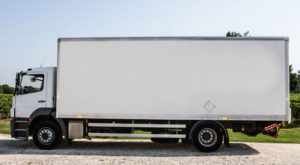
By Type of Cargo (as rigid trucks and /or semitrailers)
Box Truck is a type of a rigid truck with an attached cargo area in the shape of a cube. These trucks are also known as “cube trucks”, “cube vans”, “rolling toasters” and “box vans”.
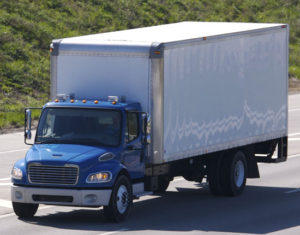
Car Hauler is a trailer, which is designed to carry passenger cars and other smaller vehicles.
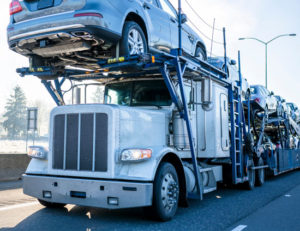
Cement Truck (concrete mixer truck) – is a type of a truck designed to mix concrete and deliver it to a construction site. By turning the drum, the truck can continually “mix” the material and maintain it in a liquid state until the time of delivery.
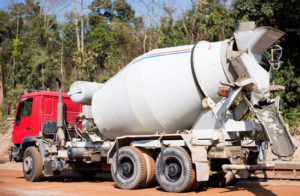
Dry Bulk Truck (typically, a trailer) – is used to transport dry bulk goods such as iron ore, plastic, resin pallets, coal, sugar, salt, cement, etc.
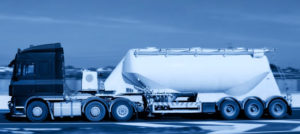
Dump Truck is a type of truck with a cargo container that can tilt and/or open at the back when it needs to be unloaded. Dump trucks are typically used for carrying loose materials (e.g. gravel, sand, or demolition waste) to and from construction sites. These trucks are also known as “tippers”.

Flatbed Truck is a truck or a trailer with a completely flat bodywork without sides or roof. This design allows loading of cargo from any angle. Flatbed trucks are used for transporting oversized cargo or cargo, which cannot fit within the dimensions of standard trucks or trailers.
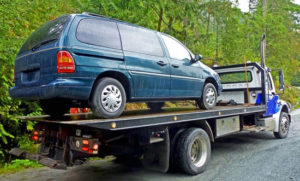
Garbage Truck is a truck designed to collect municipal and household solid waste and transport it to a waste management facility such as a landfill.
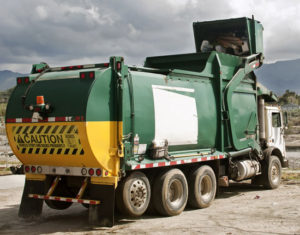
Lowboy Truck is a truck with a semitrailer that has two drops in the height of its deck: (1) one immediately after the gooseneck and (2) one immediately prior to the rear wheels. This design allows transportation of high loads as well as heavy equipment such as excavators, bulldozers, graders, loaders, asphalt rollers, etc.
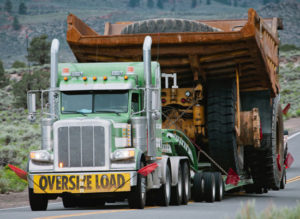
Refrigerator Truck (“Reefer”) is a truck, which is designed to transport easily perishable goods at specific temperatures.
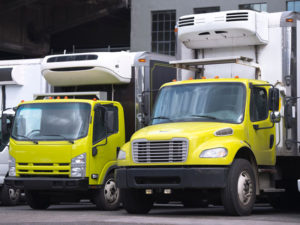
Tanker Truck is a truck (or a trailer) designed to transport liquid loads or gases.
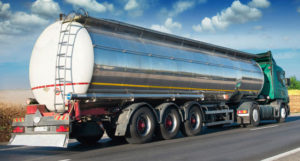
Delivery Truck (e.g. UPS, FedEx, USPS) is a truck with an enclosed cargo area. These trucks are also commonly referred to as “panel trucks”.

By Cab Body Style
Cab-over (also referred to as “cab forward”) is a body style of a truck where the cab is located above (forward of) the front axle of the truck. These cabs have vertical “flat face” hoods. The cab-over configuration is more popular in Europe than in the U.S.

Conventional Cab is a truck cab configuration where the driver seats behind the engine. This classic setup is typical for most pickup trucks and passenger cars.
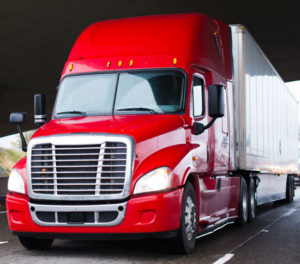
By Brand Name (in the United States)
- Mack
- Caterpillar
- CCC (Crane Carrier Company)
- Freightliner
- Ford
- Hino Motors
- Isuzu
- Kenworth
- Navistar International
- Oshkosh
- Peterbilt
- Volvo
- Western Star
Common Causes of Truck Accidents
Complex State and Federal Regulations govern large trucks with the gross weight exceeding 10,000 pounds. Truck drivers must have special commercial driver’s license (“CDL”), which require applicants and license holders to be subjected to limited alcohol and drug testing. Despite the regulations, truck accidents continue to be a major contributor to the road fatalities on the U.S. roads. For example, during the 20-year period from 1992 to 2012, there was a 10% rise in the number of fatal truck accidents. These crashes were caused by unsafe driving practices and maneuvers, equipment failures, overloading and shifting of cargo, driving under the influence of alcohol or drugs, and other causes. Victims of truck crashes need assistance of the Los Angeles truck accident lawyer who knows the complicated government regulations.
In 2007, the Federal Motor Carrier Safety Administration’s (“FMCSA”) conducted a very detailed study. This study analyzed the issue of causation of crashes involving large trucks. The study estimated that the following factors cause large truck accidents:
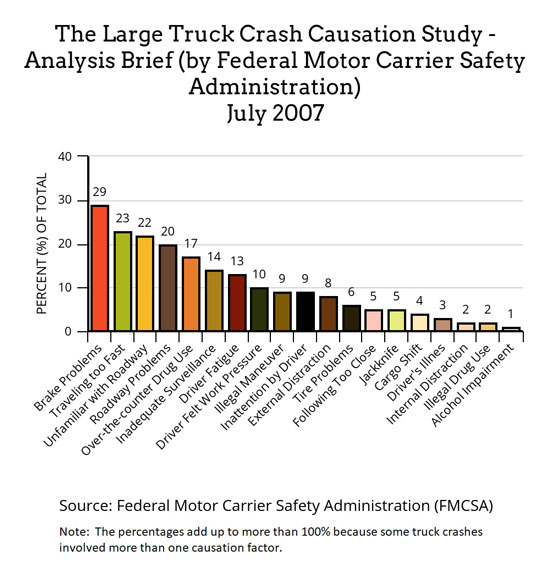
The common causes of accidents involving medium-duty trucks as well as large semi-trucks and 18-wheelers, are as follows:
Negligent Truck Maneuvers. Similar to car accidents, unsafe maneuvers represent a major cause of truck accidents. Large 18-wheelers and even medium-duty trucks can cause an accident by performing the following unsafe maneuvers:
- Jackknife Truck Accidents. An 18-wheeler or a semitrailer truck experiences a “jackknife” situation when the trailer swings from side to side or when the tractor cab and the semitrailer slide toward each other similarly to a folding knife. If a jackknife situation occurs, the “folding” semitrailer can hit nearby vehicles and even sweep them off the road, leading to tragic and devastating consequences. Jackknife accidents can be avoided if truck drivers exercise proper safety precautions while driving their big rigs. For example, if a truck driver notices that the semitrailer is swinging or moving from side to side, it may be a sign of an impending jackknife. Further, the driver must be skilled enough to be able to apply brakes slowly and avoid situations that may require the driver to slam on the brakes (e.g. speeding). A sudden brake application, especially on a wet or a curved surface, may result in a skid and lead to a jackknife. For that reason, it is the responsibility of the truck owners and trucking companies to make sure that their trucks’ brakes and tires are always well maintained.
- Truck drivers performing inappropriate Lane Changes.
- Tailgating and Truck Rear-end Crashes – driving too closely behind a passenger vehicle. Large trucks take more time to stop and require over 50% more distance to reach a complete stop. Tailgating results in an insufficient stopping distance between a truck and a passenger vehicle in front of it. When a metal monster of truck, which can weigh up to 80,000 pounds, hits a passenger vehicle from behind, the results are typically tragic and devastating.
- Trucks’ Failures to Yield when another vehicle has the right of way.
- Wrong-way Truck Driving – getting into the oncoming traffic lanes and causing head-on collisions. Considering the incomparable weight difference between a large truck and a passenger vehicle, a head-on collision is almost always fatal for the driver and passenger(s) of the small passenger car, van, or pick-up truck.
- Sharp Turns – large trucks and 18-wheelers are not designed for sharp turns. These are not race cars or even passenger cars. These trucks are simply way too long and heavy. A sharp turn can easily make the semitrailer rollover and cause a serious accident.
- “Squeeze Play” Truck Accidents – Semitrailer trucks and other 18-wheelers can reach up to 60 feet in length. For that reason, truck drivers have a practice of making wide turns, which start by a slight move in the direction opposite to the intended turn (e.g. moving to the left before making a right turn). As a result, a passenger car may get caught and “squeezed” between a curb and the truck, which frequently leads to serious injuries or fatalities.
- “Off-track” Truck Accidents – Drivers of 18-wheelers with long semitrailers must be careful not to make turns at high speeds. If a large truck makes a high-speed turn, the semitrailer can easily swing into another lane or even end up in the path of oncoming traffic.
- Truck Blind Spots, which are also called “No-zones”, are very dangerous. A large Big Rig has significant blind spots around all four sides (the front and rear, as well as left and ride sides). Truck drivers are aware of this concept, and they must act diligently and watch for smaller vehicles when making turns, changing lanes, or backing up. However, passenger car drivers have a corresponding responsibility to stay out of these “no zones” or blind spots, especially when trucks are performing maneuvers such as turns, lane changes, or driving in reverse. The classic advice for passenger vehicle drivers is: “if you cannot see the truck driver in the truck’s side mirror, then the driver cannot see you.”
Underride Crashes. These tragic accidents occur when a passenger car hits the side of an 18-wheeler’s semitrailer and gets crashed under it. The top part of the car can get severely mangled or even completely cut off. Underride crashes are almost always fatal, and each year, such accidents result in over 200 deaths.
Truck Speeding. Based on the statistical data from the Federal Motor Carrier Safety Administration (“FMCSA”), most frequently, truck accidents occur due to speeding. Unlike smaller passenger vehicles, large and heavy trucks require more time and distance to come to a complete stop. Even in perfect weather conditions, it will be a challenge for a speeding truck to stop fast enough to avoid a crash. However, when trucker drivers exceed the speed limit, and do so while tailgating or in bad weather conditions (e.g. on wet, snowy, or icy roads), this can result in a variety of tragic accidents ranging from rear-end collisions to jackknife accidents.
Inattentive Truck Driving and Distractions represents another major reason for truck accidents. Regulations applicable to the trucking industry do not allow commercial truck drivers to use smart phones, cellphones, and other hand-held devices while driving. However, some truckers continue to text and e-mail despite the regulations. Daydreaming and loss of focus can also cause a truck driver to temporarily lose sight of the road and the surroundings. Considering the massive weight and size of trucks, even the shortest-lasting distraction can lead to devastating consequences.
Driving Trucks while Fatigued or Drowsy. Sleep deprivation causes truck drivers to become tired and drowsy, which frequently leads to rear-end crashes, head-on collisions, unsafe lane changes, and accidents where trucks run off the road. A recent statistical study, which was sponsored by the FMCSA and the American Trucking Associations, showed that approximately 28% of truck drivers have some form of sleep apnea – a potentially life-threatening condition that causes sufferers to stop breathing repeatedly in their sleep. This condition causes daytime feeling of tiredness and results in a dramatic increase in the likelihood of a crash.
The Federal Motor Carrier Safety Administration (“FMCSA”) imposes strict regulations on the number of consecutive hours a truck driver can drive without a break. These rules are entitled the “Hours of Service” or “HOS” Regulations. For example, the HOS Regulations require that property-carrying commercial truck drivers may drive a maximum of 11 hours only after they have an “off duty” break of 10 consecutive hours. Some reckless truckers decide to violate the HOS rules in order to make more money. Others truck drivers may be forced by their greedy employers to drive long hours without a break. As a result, despite the detailed FMCSA regulations, fatigued, sleepy, and drowsy truck drivers continue to cause a significant number of truck accidents on the U.S. roads.
Driving Trucks Under the Influence of Alcohol. A complete alcohol intoxication is not necessary to cause an impairment. Any level of alcohol intoxication, even at very low levels of blood alcohol content (“BAC”), can impede a truck driver’s judgment and reaction time. In terms of alcohol impairment and driving, the Federal Motor Carrier Safety Administration (“FMCSA”) holds professionals with a commercial driver’s license (CDL), including bus and truck drivers, to a much higher standard than drivers of non-commercial vehicles. As a matter of public safety, the FMCSA regulations do not allow truck drivers to operate their commercial vehicles with a BAC of 0.04% or higher. Most states have adopted this limit, which is twice lower than the BAC limit of 0.08% for non-commercial drivers. In California, pursuant to Vehicle Code section 23152(d), it is a crime to drive a commercial vehicle with a BAC of 0.04% or higher. In addition, the FMCSA regulations prohibit operation of commercial vehicles within 4 hours of drinking alcohol.
In addition, one of the requirements for obtaining and maintaining a commercial driver’s license (CDL) is that truck drivers must subject themselves to routine alcohol and drug tests. Regulations require that those trucking companies, which employ truck drivers, have to implement a drug and alcohol testing program. Alcohol intoxication by truck drivers used to be the leading cause of truck accidents and related fatalities. However, the strict enforcement of the alcohol consumption safety rules by the Federal and State governments has dramatically reduced the number of truck accidents caused by drunk driving. A statistical analysis by the Insurance Institute for Traffic Safety and other transportation specialists shows that, currently, approximately only 1% of all truck accidents are caused by the truck driver’s alcohol intoxication.
Driving Trucks under the Influence of Drugs. The testing regulations and their strict enforcement have made alcohol-related truck accidents rare. However, the use of illegal drugs by truck drivers is on the rise. The Hours of Service (“HOS”) regulations by the Federal Motor Carrier Safety Administration (“FMCSA”) impose limits on the number of consecutive hours that can be driven by a truck driver without taking a break. However, in order to stay awake for longer periods, drive longer distances and make more money, truck drivers take drugs. The Insurance Institute for Traffic Safety conducted a study of 18-wheeler trucks on interstate routes, and the results were extremely troubling. The most frequently used drug was marijuana (15% of truck drivers), followed by non-prescription stimulant drugs (12%), prescription stimulants (5%), and cocaine (2%). Less than 1% of truck drivers were found to have alcohol in their blood.
- Marijuana. The most common drug used by truck drivers is marijuana. The United States Department of Transportation (“DOT”) indicated that this drug has become more easily accessible and available due to the widespread legalization of marijuana in multiple states. In 2010, the National Transportation Safety Board performed a study of 182 truck accidents with fatal outcomes. The study concluded that the use of marijuana by truck drivers led to 12.5% of the deadly crashes. The National Institute on Drug Abuse states that marijuana severely impairs drivers’ ability to safely operate a motor vehicle by impeding their reaction time, judgment, and motor coordination. The impairment can last as long as 24 hours.
- Drug stimulants – Amphetamines, Methamphetamine (“meth”), etc. Truck drivers ignore the fact that over-the-counter and prescription stimulant drugs can make them drowsy and otherwise impair their driving abilities. Prescription drugs are far more dangerous in this respect, especially when they are abused. The National Institute on Drug Abuse indicates that the use of methamphetamine is on the rise among people whose professions require them to stay mentally alert for long hours (e.g. truck drivers). Amphetamines (also referred to as “speed”) is another frequently used drug among truck drivers.
- Cocaine. The New England Journal of Medicine conducted a study and determined that, among truck drivers who had been stopped for reckless driving and had 0% blood alcohol content, 25% (one fourth) were under the influence of cocaine. Cocaine can impair the driver’s reaction time and perception. However, the most dangerous effect of cocaine is that it can lead to paranoia, hallucinations, and delusions. Just imagine the kind of devastation that a hallucinating truck driver operating an 80,000-pound machine can cause.
- Opioids. Various commentators indicate that there is a widespread painkiller and opioid abuse crisis in the United States, and some call it the “opioid epidemic.” Opioid medications may impair driving abilities by causing a variety of adverse effects such as reduced attention, coordination, and reaction time, impaired short-term memory, sedation, as well as blurred vision. Until recently, the U.S. Department of Transportation (“DOT”) did not test truck drivers for opioid use. In response to the national opioid epidemic, in 2017, the DOT expanded its drug testing panel. Starting on January 1, 2018, in addition to heroin, morphine and codeine, the DOT drug tests include the four so-called “semi-synthetic” opioid drugs: hydromorphone, hydrocodone, oxymorphone, and oxycodone. The commonly known names for these controlled substance medications include, but are not limited to, OxyContin, Vicodin, Percocet, Percodan, Tylox, Dilaudid, Lortab, Norco, Demerol, and Fentanyl (in the form of patches).
Overloading of Cargo. The proper loading and balancing of cargo is essential to the safe operation of 18-wheelers, semitrailer trucks, and other large commercial trucks. These trucks can transport up to 80,000 pounds of weight, which ranges from heavy and oversized objects to flammable and hazardous chemicals. Truck overloading, including the failure to adequately balance the cargo, can lead to the driver’s inability to control the truck. The semitrailer may overturn or rollover, the truck may swerve into the oncoming traffic, and heavy objects may fall off and either hit another vehicle or stay on the road as a hazardous obstacle. The overloaded and imbalanced cargo may simply prevent the driver from being able to safely operate the truck. The consequences can be tragic.
Shifting of Cargo. Depending on the type of the cargo, the commercial truck’s load must be appropriately blocked, braced, tied down, and otherwise secured on flatbeds or inside semitrailers. If the cargo is not properly loaded, balanced, and secured, the cargo may shift or even completely fall off the truck or a semitrailer. Sudden cargo shifts can cause jackknife accidents, rollovers, or cause the truck driver to lose control and crash.
Spills and Hazardous Materials (“HazMat”). In modern times, the trucking industry is experiencing a boom in the demand for the transportation of hazardous materials. More than 800,000 hazardous material shipments are trucked daily all over the United States, and the revenue from this business has reached the record $10 billion level. In addition to being so profitable to trucking companies, hazardous materials represent one of the most dangerous types of cargo that can be transported by truck. Typically, hazardous materials in tanker trucks are either highly flammable (e.g. crude oil, gasoline and liquified natural gas) or highly toxic (e.g. acids, pesticides, factory waste products, and radioactive waste).
- Classifications of Hazardous Materials.The Federal Motor Carrier Safety Administration (“FMCSA”) classifies hazardous materials into the following nine categories:
- 1st Category: Explosives;
- 2nd Category: Gases;
- 3rd Category: Flammable liquid and combustible liquid;
- 4th Category: Flammable solid, spontaneously combustible, and dangerous when wet;
- 5th Category: Oxidizer and organic peroxide;
- 6th Category: Poison and poison inhalation hazard;
- 7th Category: Radioactive;
- 8th Category: Corrosive; and
- 9th Category: Miscellaneous.
Every year, trucks transporting hazardous materials are involved in over 5,000 accidents, and approximately 200 of these HazMat truck crashes are fatal. When a liquid cargo spills, it can cause accidents in a variety of ways, which range from drivers swerving to avoid getting into the spilled liquid to those who skid out of control when their vehicles lose traction on the suddenly wet and slippery road.
Exposure to spilled hazardous materials can be fatal and can cause severe injuries such as thermal and chemical burns, loss of hearing, poisoning, amputation, exposure to chemicals that can cause cancer, and other injuries. Besides the risk of injury to drivers and passengers, spills of hazardous materials can cause significant environmental and property damage. For instance, when radioactive substances or toxic chemicals seep into the ground, they can contaminate supplies of water and create long-lasting health hazards for people in the affected area. Also, toxic fumes can lead to severe respiratory problems and other health risks.
Poor Road Conditions. In some cases, a negligently designed or maintained roadway can cause an accident. For example, open potholes may lead to the loss of control. Overgrown trees on the road or at an intersection may cause visual obstructions and prevent drivers from seeing critically important signs and warnings. If faulty road conditions cause or contribute to a truck accident, local government entities and/or private companies contracted to maintain roadways – may be held responsible for the crash and the resulting injuries or fatality.
Inadequate Work Zone Warnings. During the periods of highway construction or maintenance, work zones must comply with proper design procedures. The setup of work zones along highways must account for various factors, including the longer distance that trucks need to stop, posted speed limits in the affected area of the highway, expected traffic conditions and congestion, and other factors. In addition to the barriers and space separating highway workers from the traffic, adequate signs and warnings must be posted to allow drivers (truck drivers in particular) sufficient time to slow down. If work zones are not set up in compliance with the pertinent safety guidelines, and it leads to a truck accident, the companies contracted to perform highway maintenance or construction may be held liable for the accidents and the resulting damages.
Longer Combination Vehicles (LCVs). Due to their size and length, LCVs are more difficult to operate than standard 18-wheelers / semitrailer trucks or even twin trailers. This makes these trucks highly dangerous, because they are prone to rollovers, jackknife accidents, and situations where drivers lose control and are unable to regain control of the vehicle.
Truck Equipment Failures. Human errors cause the vast majority of truck accidents. However, in some cases, failures of truck equipment cause or contribute to crashes. Parts and components that may cause truck accidents include, but are not limited to, the following:
- tires
- brakes and related systems (e.g. compressed air tanks and brake lines)
- power trains (engines, transmissions, drive shafts)
- axles
- wheels
- electronic engine monitoring equipment as well as
- hitches and other coupling systems.
The Insurance Institute for Highway Safety (“IIHS”) refers to a study that was performed in 2010 with respect to inspections of trucks conducted after crashes. The study revealed these results: (a) over 50% of trucks involved in accidents had at least one mechanical problem that was in violation of the Federal Motor Carrier Safety Administration (“FMCSA”) regulations; and (b) nearly 30% of the inspected trucks had at least one mechanical issue that warranted taking the truck out of service. Truck equipment failures occur due to either defective parts or neglected maintenance. In cases of equipment malfunctions and defective parts and components, manufacturers or distributors can be named as defendants in a product liability cause of action.
Negligent Truck Inspections. Based on the recent data from the FMCSA, out of over 2 million inspected trucks, more than 23% had significant mechanical and safety violations. Even though FMCSA and other regulatory entities make their best efforts to inspect trucks and get them off the road until they are in compliance with safety regulations, many unsafe and poorly-maintained trucks are still on the road causing catastrophic crashes and fatalities.
Regulatory Violations by Trucking Companies. Trucking companies can be held liable for truck accidents and the resulting consequences if they engaged in the following regulatory violations:
- Failure to perform background checks on truck drivers and those who are responsible for the truck maintenance
- Hiring truck drivers with poor safety and driving records, DUI convictions, and the history of reckless driving
- Failure to properly train truck drivers
- Failure to properly maintain the truck and/or its semitrailer
- Failure to inspect and scrutinize the driver’s log books
- Failure to enforce the federally-mandated Hours of Service (“HOS”) regulations
Potential Defendants in a Truck Accident Case
Every truck accident case may involve multiple parties, which include the following:
- the driver of the truck
- the owner of the truck
- the owner of the trailer (if it is a semi truck)
- the party (an individual or a company), which leased and/or rented the truck from an owner
- the party (an individual or a company) that leased and/or rented the trailer from an owner
- the loader of cargo
- the shipper of cargo
- the manufacturer or distributor of any failed equipment, including tires and brakes, can be named a defendant in a concurrent Product Liability claim.
Safe Driving Practices – Avoiding Truck Accidents
Several safe driving practices may help drivers avoid some truck accidents. An overview of these safe practices by the Los Angeles truck accident lawyer is as follows:
Avoid Blind Spots (“No-Zones”) of Trucks
Many people share an assumption that, just because truck drivers sit so high in their cabs, they must be able to see the road better. This assumption is not accurate. Large trucks, especially 18-wheelers and semi-trucks have significant blind spots (also called “No-ones”) in four areas: in front of the truck, in the rear of the truck, and on both sides of the truck.
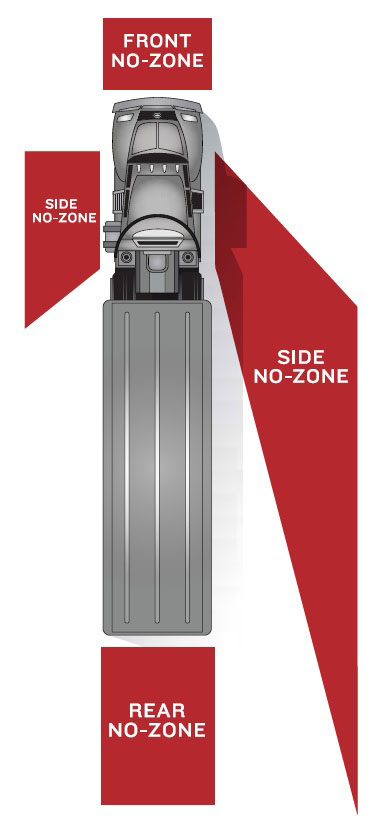
- The Front No-Zone extends almost 20 feet ahead of the cab, and a car can easily become “invisible” in that area.
- The Rear No-Zone area is extremely large and covers almost 200 feet behind the truck. When a passenger vehicle is in the truck’s rear blind spot, the danger doubles: not only is the smaller vehicle “lost” for the truck driver, but also the car’s front view becomes obstructed and it reduces the reaction time in case a truck makes a sudden stop.
- The long Side No-Zones cover both sides of the tractor and then extend out at an angle covering the front part of the semitrailer. For the U.S. truck drivers, who sit on the left side of the truck cab, the right No-Zone is much larger than the left one. A truck driver may decide to make a lane change and, if you are driving in one of the side blind spot areas, the truck can easily sideswipe your vehicle. The best truck driver in the World will be simply unable to see your vehicle. For that reason, motorists are advised to avoid cruising alongside 18-wheelers. When passing a semi-truck, allow yourself sufficient space and time to perform this maneuver.
Trucks are not equipped with rear-view mirrors. For that reason, truck drivers have to rely on their side-view mirrors, which can reach 25 inches in size. Today’s trucks can be equipped with cameras; however, it is still not sufficient to enable truck drivers to visualize absolutely everything around the truck. Motorists must always avoid trucks’ No-Zones.
Never Drive Too Close In Front of Trucks
Compared to passenger vehicles, large trucks such as 18-wheelers and semi-trailers require significantly more time and distance to come to a complete stop. Drivers of smaller vehicles should always make sure there is sufficient space between the back of their car and the front of the truck behind them. Most importantly, never cut in front of a truck! Such a mistake can be fatal. A commercial truck can weigh up to 80,000 pounds and, if it slams into a passenger vehicle, it will crush it. It does not mean drivers should avoid passing trucks or driving in front of them altogether. It can be safe when done correctly – i.e. by maintaining a sufficient distance. When merging in front of a truck, a good rule of thumb is to make sure there is at least one car-length of space for each 10 miles per hour of your speed at the time. In other words, if you are traveling at the speed of 60 miles per hour when passing a truck and merging in front of it, the truck should be far enough behind you to fit 6 cars in that space. This will not only allow the truck driver to see you, but it will also save your life if an unexpected situation makes you suddenly slam on the brakes.
Never Follow Trucks Too Close
Because of trucks’ huge rear blind spots, a truck driver will not be able to see a passenger vehicle behind it unless the distance between them is over 200 feet. Multiple potential reasons may force an 18-wheeler to stop suddenly and unexpectedly. It can be an accident, a person or an animal trying to cross the highway, a tire blow-out or a mechanical issue, or a large obstacle on the road. Whatever the reason, if a heavy truck decelerates rapidly, and a passenger vehicle is too close behind it, it will inevitably crash into the back of the truck. Low passenger cars may end up sliding completely under the truck chassis or the semitrailer. The results are always tragic. Never tailgate trucks! When driving behind a truck, a good practice is to keep the distance sufficient to be able to see the side-view mirrors on both sides of the truck. Many trucks even have the following signs on the back: “If you can’t see my mirrors, I can’t see you!”
Maintaining a safe distance when following trucks becomes even more important when travelling uphill. The gross weight of fully loaded semitrailer trucks can reach 80,000 pounds. For comparison, an average elephant weighs approximately 10,000 pounds. Pulling such weight uphill is a tremendous task – even for powerful truck engines. A truck’s engine may overheat, or the driver may inadvertently miss a gear or even shift the transmission into neutral. As a result, the truck may make a sudden stop, stall, or even roll backwards. Also, poorly secured cargo may end up falling out of the semitrailer.
When driving behind any vehicle, especially a truck, the National Safety Council recommends a minimum 3-second following distance. When following a truck, pick any point of reference or a marker on the side of the road – for example, a tree or a road sign. When the truck ahead of you passes that point of reference, determine how many seconds it will take your vehicle to reach the same point. If you reach that spot in less than 3 seconds, than means you should slow down and make sure the distance between your vehicle and the truck is larger.
Give Trucks Space to Turn – Avoid “Squeeze Play” Situations
Due to their enormous length, semi-trucks make wide turns, especially right turns. Some trucks even have signs on them, which say: “Caution. Wide Turns.” Avoid getting squeezed between a truck’s trailer and a curb. If the driver of a passenger vehicle does not does not give the truck adequate room to make a turn, the damage can range from a deformed or separated bumper to a completely mangled car and severe injuries of its occupants.
On Windy Days, Exercise Caution When Passing Trucks
Side winds can be powerful enough to blow a car off the road. Such strong winds are even more dangerous for tall and big 18-wheelers. A truck’s center of gravity is much higher than the center of gravity of a smaller passenger vehicle. In addition, the wide flat side surface of a semitrailer acts as a “sail”. As a result, a strong wind can easily overturn a semi-truck, especially when it is not carrying any cargo. Therefore, drivers of smaller vehicles must exercise caution when attempting to pass trucks on windy days. When passing a truck on a freeway, leave a lane between your vehicle and the truck. If it appears that the semitrailer is swaying from one side to another, then it is not a good idea to pass this truck.
Sharing the Road with Trucks During Bad Weather
While driving in rainy weather, motorists should make sure they maintain a safe distance from other vehicles, especially trucks. This practice will not only make a passenger vehicle more visible to the truck driver, but it will also enable the passenger vehicle to make a sudden stop, if necessary. If you are following too closely behind a large truck, the truck’s spinning rear wheels can generate a huge water spray that will completely cover your windshield—temporarily blinding you. Make sure your windshield wipers are always in good working condition.
Practice defensive driving. Use signals when passing a truck or making a turn, and avoid reckless driving habits such as speeding and swerving in order to pass a slower-moving truck.
What Damages Can be Recovered in Truck Accident Cases?
Victims of truck accidents can claim the following two main types of damages: Non-Economic and Economic damages. In some situations, those who have been injured in a truck crash may potentially seek Punitive Damages. For cases involving future care, the Los Angeles truck accident attorney at Cherepinskiy Law Firm retains top expert physicians, life care planners, and economists to evaluate clients’ needs and present the best case on their behalf. A detailed discussion of the recoverable damages is included on the Personal Injury Damages page of this website. If a truck accident resulted in the death of a loved one, then compensation can be sought in a Wrongful Death action.
This Firm’s Los Angeles Truck Accident Attorney Can Help
Matters involving truck accidents are significantly more complicated than those involving passenger car accidents. It is important that victims of truck accidents seek the assistance of the truck accident lawyer Los Angeles residents can count on. Cherepinskiy Law Firm is highly experienced and skilled, and it knows how to successfully pursue complex truck accident cases.
Truck Accident Cases Are Highly Complex
These are some of the factors, which make truck accident matters very complicated:
- Complicated and detailed Federal regulations govern all aspects of the trucking industry. These regulations include drug tests, limits on shift hours, medical examinations, record keeping, and reports. Therefore, an attorney who is investigating a truck accident must have a thorough understanding of these regulations.
- Given the tremendous weight of commercial trucks, crash sites typically involve a much larger radius and more debris. As a result, a very large number of evidence items must be accounted for, collected, photographed, analyzed, and examined.
- After a truck crash, a trucking company as well as its investigators and attorneys – all rush in to protect the driver and the company from the legal responsibility for and the financial ramifications of the accident. They invest significant time, money, and resources to generate the legal defense. The Los Angeles truck accident lawyer at Cherepinskiy Law Firm can handle this defensive avalanche, and push the case to a successful resolution.
- There are multiple parties involved in the trucking industry who may potentially share a certain degree of fault for the accident. Besides the driver, these potential additional parties range from the trucking companies to loaders and equipment manufacturers.
This Firm Builds Strong Cases
This firm uses the most comprehensive and unique strategies to uncover all necessary evidence and build the strongest possible cases for the truck accident victims. These strategies include, but are not limited to, the following:
- Interviewing witnesses
- Taking detailed photographs of the crash site and debris
- Taking depositions of truck drivers, managers and employees of trucking companies, and any other individuals who may potentially reveal useful information regarding a driver’s negligent propensities or a company’s negligent practices
- Requesting examinations of the wrecked trucks
- Requesting production of multiple items of evidence such as:
-
- The trucks’ Event Data Recorder (“EDR”). This device is typically referred to as an automotive “black box” (using the terminology widely accepted in the airline industry). Modern large trucks are equipped with tamper-proof EDR’s, which electronically record engine problems or sudden changes in speed. This information can subsequently be analyzed to investigate the cause of a crash
- Recordings of in-cab video monitoring cameras and systems
- Any available surveillance video pertaining to the accident
- The truck driver’s cell phone records – to see if the driver was distracted at the time of the accident
- Driver’s Log Books and Time Cards
- Schedules of Routes
- Trip Sheets
- Any other logs, recordings, and data generated by the driver or anyone on the driver’s behalf for the pertinent time period(s)
- Truck inspection and maintenance reports and records
- Post-accident inspection reports and records
- Retaining accident reconstruction experts and specialists who can evaluate the evidence, discover the cause of a crash, as well provide powerful exhibits that will illustrate for juries exactly what caused the crash. These exhibits range from colorful illustrations to complex computerized animations.
Overall, once this firm evaluates the truck accident, its cause, and the damages, a demand for full compensation is made to the relevant insurance carrier(s). When you need an effective negotiator and an aggressive trial attorney, the Los Angeles truck crash lawyer at Cherepinskiy Law Firm fits the bill perfectly. This firm leaves no stone unturned and prepares strong cases, which enables the firm to negotiate with insurance companies from a position of strength. If an insurance carrier is not willing to settle the case, this firm is ready to proceed to trial.
Get a Free Consultation! Promptly Contact Truck Accident Attorney Los Angeles Residents Can Rely On
The value of any truck accident claim depends, in part, on what you do immediately after the accident and subsequent to that. Your decisions and actions can seriously impact your claim and the amount of your potential recovery. Read this firm’s discussion of Twelve Steps to Take After a Motor Vehicle Accident to learn about post-accident safety, obtaining and preserving evidence, dealing with insurance companies, and other useful tips.
If you believe a truck driver’s carelessness caused your injuries or a loved one’s death, please call or fill out an electronic contact form today to request a free consultation. Cherepinskiy Law Firm, as the Los Angeles truck accident lawyer, will work in a tireless and compassionate manner in a personal injury or a wrongful death case to make sure you are compensated for your injuries and losses. Cherepinskiy Law Firm is the proverbial David ready to go to battle with any corporate Goliath with deep pockets.
This firm fights for clients throughout California, including Los Angeles, Orange County, as well as Ventura, Riverside and San Bernardino Counties.
Sources
1. https://www.fmcsa.dot.gov/safety/data-and-statistics/large-truck-and-bus-crash-facts
2. https://www.fmcsa.dot.gov/research-and-analysis/research/large-truck-crash-causation-study
3. https://crashstats.nhtsa.dot.gov/#/
4. https://www.iihs.org/topics/fatality-statistics/detail/large-trucks







